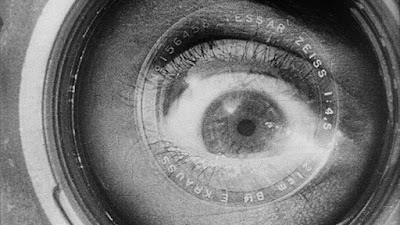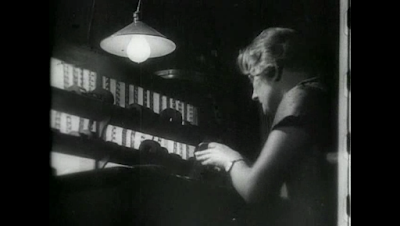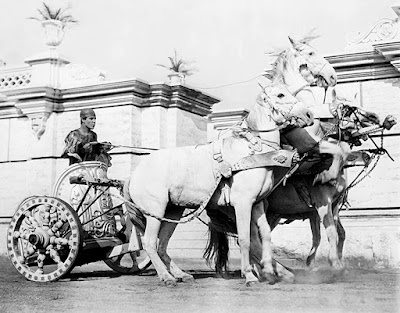Buster shows off an old-time boxing stance in 'Battling Butler.' Get those gloves up, Keaton!Ding!
Next up is Buster Keaton's boxing comedy 'Battling Butler' (1926), which I'm accompanying on Wednesday, April 27 at the Flying Monkey Moviehouse and Performance Center in Plymouth, N.H.
Hope you'll join us for this screening, part of a series of films released in 1926 that became public domain as of Jan. 1, 2022.
You the public now own 'Battling Butler.' Aren't you interested in seeing it?
The complete press release with more info is at the bottom of this post.
For now, a few thoughts about my recent three-day visit to Cleveland, Ohio. (I'd call it a "flying visit" but I actually drove out there and back—about 10 hours each way.)
The reason was the 47th annual sci-fi marathon at Case Western Reserve University, where I accompanied the early German film 'Der Golem' (1920). The festival usually takes place in January, but was postponed this year due to the Coronavirus spike at that time.
It got rescheduled to last weekend, and it worked out that I could get out there as planned.
I then reached out to the folks at the Cleveland Cinematheque, where I've been privileged to accompany silents, with news that I'd be in town, and so they asked me to do 'Nanook of the North' (1922).
Thus I drove to Cleveland—out on Friday for shows that night at the Cinemathèque, then the next day at the sci-fi festival, then back east to arrive in time to accompany a 2 p.m. screening of the silent 'La Bohème' (1926) at the Somerville Theatre.
Why drive? Because I used my big-ass digital synthesizer at each of the venues, and it's really not practical to put that on a plane.
Plus, even with gas more expensive and the absurdly high tolls on the New York State Thruway, it's cheaper to drive. That includes wear and tear on my Subaru Forester, which recently passed the 240,000 mile mark.
Plus, if I flew, I could not stop in Erie, Pennsylvania at the one Krispy Kreme donut franchise along the way.
So it's silent film accompaniment, with a little bit of long haul trucking thrown in. Ah, the glamour of show biz!
The Cinematheque drew a respectable audience for 'Nanook,' for which I used a light texture (mostly harp) for the first 20 minutes but then switched to full orchestral sound for the sea lion hunt and then for the rest of the picture.
'Nanook' was preceded by a Buster Keaton short, 'The Frozen North,' thus creating a theme for the program. I wondered aloud if we should turn up the air conditioning.
As always, John Ewing and Genevieve Schwartz and everyone else at the Cinematheque were terrific hosts. As usual, I took the opportunity (as an outsider) to remind everyone how fortunate Cleveland was to have a theater committed to running such diverse programming all year round.
I had told John about 'Straight is the Way' (1921), the obscure Cosmopolitan Pictures comedy/drama set in my home state of New Hampshire and recently pried loose from the Library of Congress vaults via a Kickstarter project by Ed Lorusso.
So John decided to run it as an unofficial bonus feature following 'Nanook.' Only a few people stayed, but together we witnessed the "Midwest Re-Premiere" of a film that hasn't been seen anywhere for more than a century.
An unknown film with no one famous in it does not make for great expectations. But once again, 'Straight is the Way' proved moderately entertaining, much to everyone's surprise. So I plan to keep programming it, and say thanks again to Ed L. for making the title available.
As for the sci-fi marathon: what a blast from the past! People getting together for a 36-hour shared experience—a real throwback to the era not just prior to the pandemic, but also before streaming and everything available at any time.
An attendee arrives at the sci-fi marathon with her Mystery Science Theatre 3000 companion. While I appreciate the convenience of digital-streaming-everything-on-demand-in-the-comfort-of-your-home-when-you-want-it, I remain a complete slave to cinema as a shared experience.
I think it's the best and most satisfying way to experience cinema, and especially films from the silent era. For me, it's certainly the most rewarding way to accompany them. And personally, I just like it better.
So it did my heart good to see people fussing over film prints in a projection booth, setting up camp among the seats of Case Western's Strosacker Auditorium, and just generally being enthused at the idea of seeing favorite and not-so-favorite flicks on the big screen.
A peek inside the booth, with impromptu conference in progress.
Getting to be a rare sight: actual cans of actual film!'Der Golem' was set for Saturday at 4:30 p.m., about halfway through the marathon. I arrived about halfway through the previous film. It was billed as a "surprise" and turned out to be an original 35mm release print of Star Wars (1977), now retitled "Episode 4: A New Hope."
So after readying all my stuff backstage for quick deployment, I went around and took a seat in back to catch the last 30 minutes of this film, which I hadn't seen in decades. Although the print was badly faded, people were into it. People were shouting comments and wisecracks, as often happens in this kind of setting, and which is all part of the fun.
I then set up for 'Der Golem' and was once again thrilled to hear how good my beat-up Roland speakers sound when placed on the Strosacker's wooden stage. The music just leaps to life. After running through a few chord progressions, I heard someone behind me say, "Awesome!"
After running through a Koko the Clown cartoon as a warm-up, we went straight into 'Der Golem' and I have to say, everything just fell into place. There was something about the silent image and the live music and that audience that gave everything a majesty and portentousness that otherwise would not have happened.
Things got especially powerful during the amazing sequence when the Rabbi conjures up evil spirits to find the secret word to bring life to the inanimate. I used a steady 3/4 beat throughout, starting very simply, over which I wove increasingly frenetic figures until finally reaching something like the spirit of Ravel's "La Valse," described somewhere as a dance on the edge of a volcano.
You could tell there was genuine audience engagement, especially when the creature begins to turn on its creators. Wow! You just can't experience tension, anticipation, and energy like that at home. And 'Der Golem' is a very satisfying film in that respect, as it all gets released in the film's climactic sequence.
I was gratified to receive a hearty ovation, but gestured to the screen behind me, as that's what it's all about.
A view of the auditorium Friday afternoon, before most attendees arrived.Alas, attendance at the sci-fi festival was clearly down from my last appearance here, in January 2020, just before the pandemic took hold. Then, for a screening of 'Aelita, Queen of Mars' (1924), we had to move people (and their sleeping bags) around to make room for my keyboard. This time, there were acres of open space.
Yes, the pandemic has had an effect. And yes, times are changing.
A stuffed cat in the Strosacker Auditorium.But I hope the spirit that's part of the DNA of this festival and similar ones—the sense of wonder and love of cinema that prompted people to create such communal events in the era before VCRs and DVDs and everything-on-demand—will persist as we all march forward.
Afterwards, I pointed the Subaru Forester east towards Boston, arriving in time (with an overnight stay in Syracuse, N.Y.) for the matinee of 'La Bohème' at the Somerville Theatre.
Silent film on the Somerville's big marquee! The screening marked the return of the venue's 'Silents, Please!' series after a long pandemic-induced hiatus. In welcoming back the audience, I recalled how the last silent at the Somerville was on Sunday, March 15, 2020, when the theater screened Rin Tin Tin in 'Clash of the Wolves' (1925) to a smaller-than-usual crowd.
"I remember at the time talking with Ian Judge, the Somerville's manager, and thinking that this pandemic thing might cause theaters to have to close for as much as two weeks, or maybe even a month," I said, to knowing laughter.
I also got laughs with an off-the-cuff remark about the music.
"If you're expecting to hear Puccini's immortal music, I'm afraid you're going to be disappointed," I said. "What I do will be mostly improvised, and I'm not Italian, so it wouldn't sound like Puccini even if I tried. I'm Polish and Lithuanian, so I might be able to go for Witold Lutosławski."
Of course it's a real question: for a silent film version of a famous opera such as 'La Bohème,' what role should music play? My answer: same as always. The accompaniment should support the story, the characters, the action, the emotions, the changes of mood, and everything else happening on the screen.
At its best, the music helps a silent film cast a spell on an audience—and that's true for 'La Bohème' as much as any other story. In fact, I think if I did try to channel Puccini, that would only take people out of the on-screen narrative, which would be a distraction.
So I didn't channel Puccini, nor Lutosławski, nor anyone else. I just reached into my own reservoir of strong feelings and emotions and tried to conjure music that helped the film connect.
As usual, it was a mix of deliberate calculation and in-the-moment reaction.
Prior to the screening, I had decided an all strings texture was right for this kind of film, which gives audiences a chance to soak in a prolonged emotional bath.
But for those big moments with Lillian Gish and John Gilbert filling up the screen—where the soaring melody over lush chords came from, I really couldn't tell you.
It certainly wasn't the hotel in Syracuse.
Okay, enough about the road trip. Here's all you need to know about 'Battling Butler' on Wednesday, April 27 at the Flying Monkey. Hope to see you there!
* * *
Buster gets physical in 'Battling Butler' (1926).TUESDAY, APRIL 12, 2022 / FOR IMMEDIATE RELEASE
Contact Jeff Rapsis • (603) 236-9237 • jeffrapsis@gmail.com
Buster Keaton's 'Battling Butler' at Flying Monkey Moviehouse on Wednesday, April 27
Silent film series continues with knockout boxing comedy focusing on the fight game, accompanied by live music
PLYMOUTH,
N.H.—He never smiled on camera, earning him the nickname of "the Great
Stone Face." But Buster Keaton's comedies rocked Hollywood's silent era
with laughter throughout the 1920s.
Acclaimed for their originality, clever visual gags, and amazing stunts, Keaton's films remain popular crowd-pleasers today.
See
for yourself with a screening of 'Battling Butler' (1926), one of
Keaton's landmark feature films, on Wednesday, April 27 at 6:30 p.m. at
the Flying Monkey Moviehouse and Performance Center, 39 Main St.,
Plymouth, N.H.
Admission is $10 per person. Live music will be
provided by accompanist Jeff Rapsis, a New Hampshire-based performer who
specializes in creating music for silent film presentations.

'Battling
Butler' tells the story of pampered millionaire Alfred Butler (Keaton)
who tries to impress the girl of his dreams (Sally O'Neil) by pretending
to be a championship boxer with the same name.
The masquerade
leads to knockout comedy both in and outside the ring, giving Keaton
ample opportunity to display his gifts for physical and visual comedy.
The
screening is the latest installment of the Flying Monkey's series
showcasing the best films of 1926, all of which entered the public
domain on Jan. 1, 2022.
In the 1920s, boxing rivaled baseball as
the nation's most popular sport. Neighborhoods, communities, and ethnic
groups all rooted for their favorite fighters, and heavyweight champion
Jack Dempsey ranked as an international celebrity.
Because of this, boxing stories were popular with early movie audiences as well.
"As
an elemental contest between two opponents, boxing inspired early
filmmakers to do some great work," Rapsis said. "It's a visual sport
that doesn't require a lot of dialogue or commentary to understand, and
so was perfect for silent movies."
Keaton, along with Charlie Chaplin and Harold Lloyd, stands as one of the silent screen's three great clowns.
Many
critics regard Keaton as the best of all; Roger Ebert wrote in 2002
that "in an extraordinary period from 1920 to 1929, (Keaton) worked
without interruption on a series of films that make him, arguably, the
greatest actor-director in the history of the movies." But while making
films, Keaton never thought he was an artist, but an entertainer trying
to use the then-new art of motion pictures to tell stories and create
laughter.
All those talents are on display in 'Battling Butler,'
which holds the distinction of being the top-grossing title of Keaton's
silent features.

The Flying Monkey's silent film screenings
provide local audiences the opportunity to experience silent film as it
was intended to be shown: on the big screen, in restored prints, with
live music, and with an audience.
“These films are still exciting
experiences if you can watch them as they were designed to be shown,”
said Rapsis, accompanist for the screenings.
“There’s a reason
people first fell in love with the movies, and we hope to recreate that
spirit. At their best, silent films were communal experiences in which
the presence of a large audience intensifies everyone’s reactions.”
The
screening of 'Battling Butler' is the latest in the Flying Monkey's
series celebrating films that recently entered the public domain.
Copyright protection for all U.S. films released in 1926 expired on Jan. 1, 2022.
To
mark the occasion, the Flying Monkey is showcasing vintage 1926
comedies, dramas, and adventure films, all with live music, and all now
in the public domain.
Upcoming screenings in the Flying Monkey's "Public Domain Extravaganza" series include:
• Wednesday, May 11, 2022, 6:30 p.m.: "Bardelys the Magnificent"
(1926) starring John Gilbert. Gilbert tries his hand at swashbuckling
in this big-budget MGM historical extravaganza about exploits of an
unjustly disgraced French nobleman. A major film long thought lost until
a single print was recently discovered in France.
• Wednesday, June 8, 2022, 6:30 p.m.: "The Black Pirate"
(1926) starring Douglas Fairbanks, Sr. The original pirate
swashbuckler, with Fairbanks sword-fighting his way through a period
adventure tale set during the age of sailing ships.
"By 1926, the
movies had matured enough to offer a wide range of great entertainment
that still holds up today," Rapsis said. "Come see for yourself as we
screen some of the year's best flicks, all of which recently entered the
public domain and now belong to us all."
Buster Keaton stars in
'Battling Butler,' to be shown on Wednesday, April 27 at 6:30 p.m. at
the Flying Monkey Moviehouse and Performance Center, 39 South Main St.,
Plymouth, N.H.
Admission is $10 per person. For more info, call (603) 536-2551 or visit www.flyingmonkeynh.com.

































